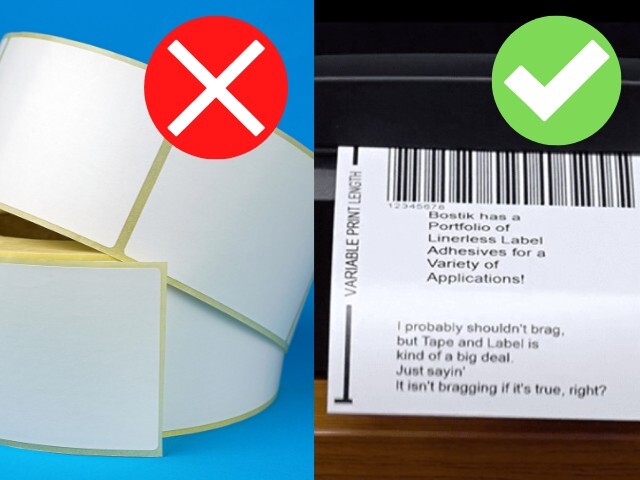Dec 6, 2022 - 3-5 minutes
How to Overcome Paper-Based, Release Liner Shortage Challenges

Learn how using linerless labels can help you avoid dealing with release liner issues while also making simple, affordable changes to your processes.
As a label manufacturer, you know one of the biggest struggles in recent years has been finding release liner materials. This is because around 500,000 tons of release liner are used in the North American market, yet continuous paper mill shutdowns, supply chain disruptions and increased global market prices have made obtaining the liner material very difficult to secure. Therefore, while you may have previously relied on one source for release liner materials, it’s likely you now have to find multiple suppliers for everything needed, which can slow down your overall production processes.
Fortunately, one solution greatly decreases these material sourcing challenges. Learn how going completely linerless with your label applications can help you avoid dealing with release liner issues while also making simple, affordable changes to your processes.
What are Linerless Labels?
How Linerless Labels Overcome Challenges with Release Liner Shortage Challenges
With fewer release liner materials available, there’s more pressure to quickly find a solution without increasing material expenses and overall production costs. Linerless label solutions help you address the following challenges:
- Paper mill closings: With a string of recent paper mill closures, you don’t need to worry about finding paper release liner replacement. Rather than spending valuable production time looking for a new supplier, you can focus on moving forward with new processes that are easy to implement while simplifying operations and reducing overall material waste.
- Supply chain disruptions: A label can consist of several layers, including the liner, adhesive, substrate, ink and laminate or top coat. This means you must ensure you have all these materials at the same time to fulfill production needs in a timely manner. Since you do not need a release liner with a linerless label, you can reduce the number of label layer materials you must order, track and receive on time to ensure you’re supplying a finished label product. This will provide you more time to address other possible supply chain disruptions and help move production along quickly with fewer materials needed to start operations.
- Increased global market costs: Linerless label materials are available in the U.S. market, allowing you to avoid international shipments. Further, advancements have been made over the years to simplify linerless label manufacturing equipment, reducing added costs for printer maintenance issues.
Additional Linerless Labels Advantages
- Improved production: Eliminating the release liner improves worker safety, as liners can pose a safety hazard if any material falls on the facility floor. Additionally, linerless labels require fewer roll changes than traditional, release liner labels, since more labels fit on a roll. This allows manufacturers to move through production faster when compared to traditional labels, helping them deliver products quickly.
- Increased sustainability: Without a release liner, there is less overall material to dispose, helping manufacturers decrease their waste production costs. Additionally, linerless labels offer reduced weight compared to traditional labels, enabling more labels to be packaged and transported at a time, lowering overall carbon emissions.
- Seamless printing: Previously, there have been misconceptions that linerless label adhesives are too tacky to efficiently work through a printer; however, linerless labels can, in fact, easily pass through without jamming. By using specially formulated hot melt technology with a controlled tack, they build adhesion quickly for a strong bond on the final substrate without an adverse effect in direct thermal printers.
- Strong performance: Linerless labels can be manufactured with a wide range of adhesive options, ensuring the final product will meet specific application bonding needs. For example, hot melts provide ideal adhesion for difficult-to-bond substrates, and emulsion is particularly useful for sensitive printers. Additionally, top coats or over print varnishes can be added to a linerless label without adverse effects to the final performance.
- Reduced manufacturing costs: Most manufacturers report savings in shipping costs up to 40 percent after switching to linerless labels, as the reduced weight helps improve overall carbon emissions and fewer roll changes allow for production to speed up. Additionally, more labels can fit a roll since there is no release liner, helping save on storage space and transportation costs. Further, there is no gap between the labels, allowing the labels to be cut to the exact length needed. With the ability to save over 20% in label material waste*, eliminating the gap also reduces costs per label and freight costs.

How Bostik Can Help Manufacturers Overcome Release Liner Shortage Challenges
As you look for alternative options to release liners, we are here to provide insight on the latest adhesive technologies that provide easy, cost-effective changes while also heightening sustainability in your processes. Bostik’s expertise in linerless label adhesives will guide you to the most beneficial practices, materials and equipment to ensure you achieve top end-use performance for your application. Our linerless label adhesives have controlled tack levels that can run well through mobile, desktop, high-speed or other types of printers without the concern of jams or wraps. Designed with end-use application in mind, our linerless label adhesives can be auto-applied or adhered at various temperatures to meet the necessary performance needs.
contact an expert
Thinking linerless labels are the right solution to your release liner challenges? Contact a Bostik representative today to learn how linerless label adhesives can help you overcome market challenges and improve your processes.
contact an expert
